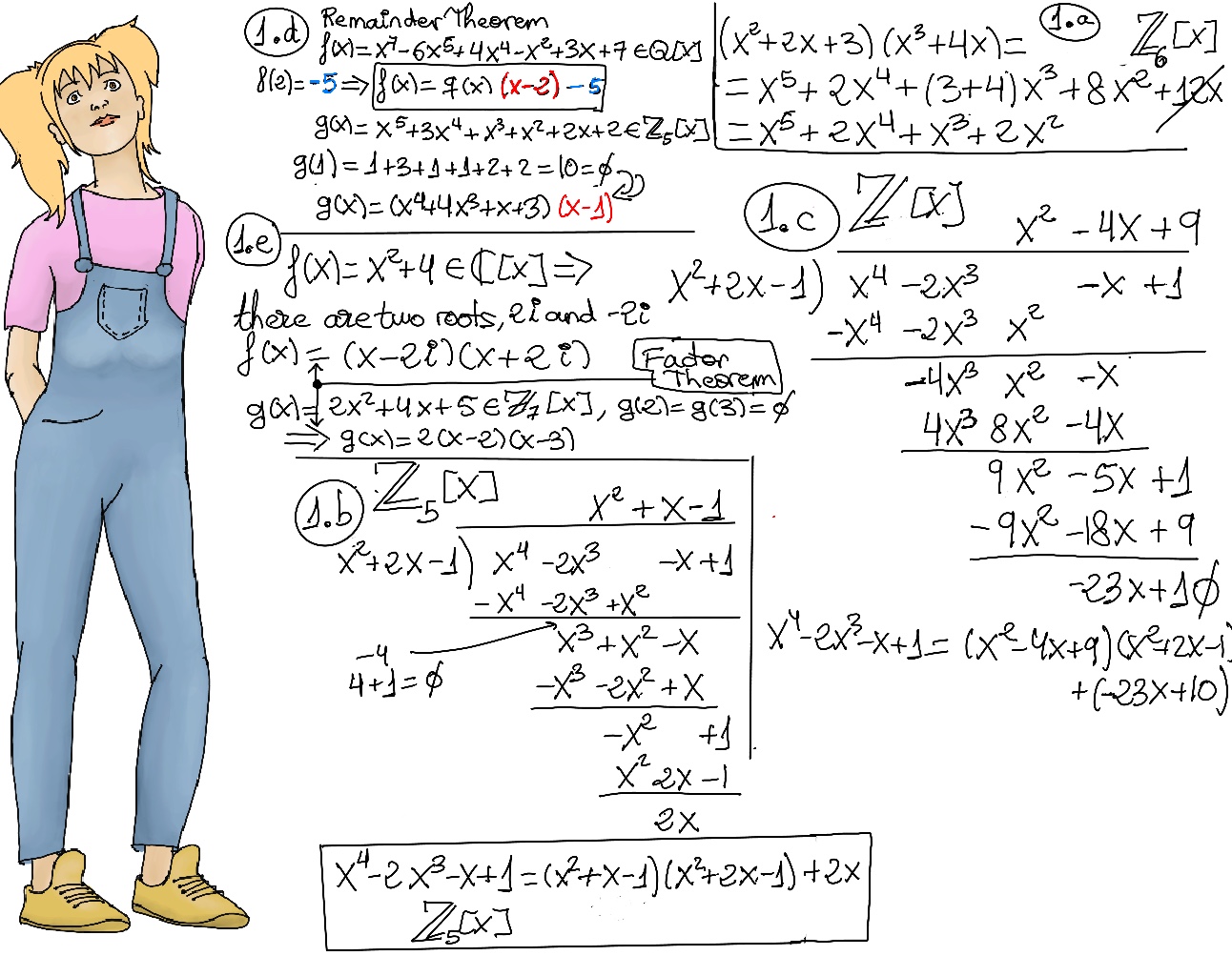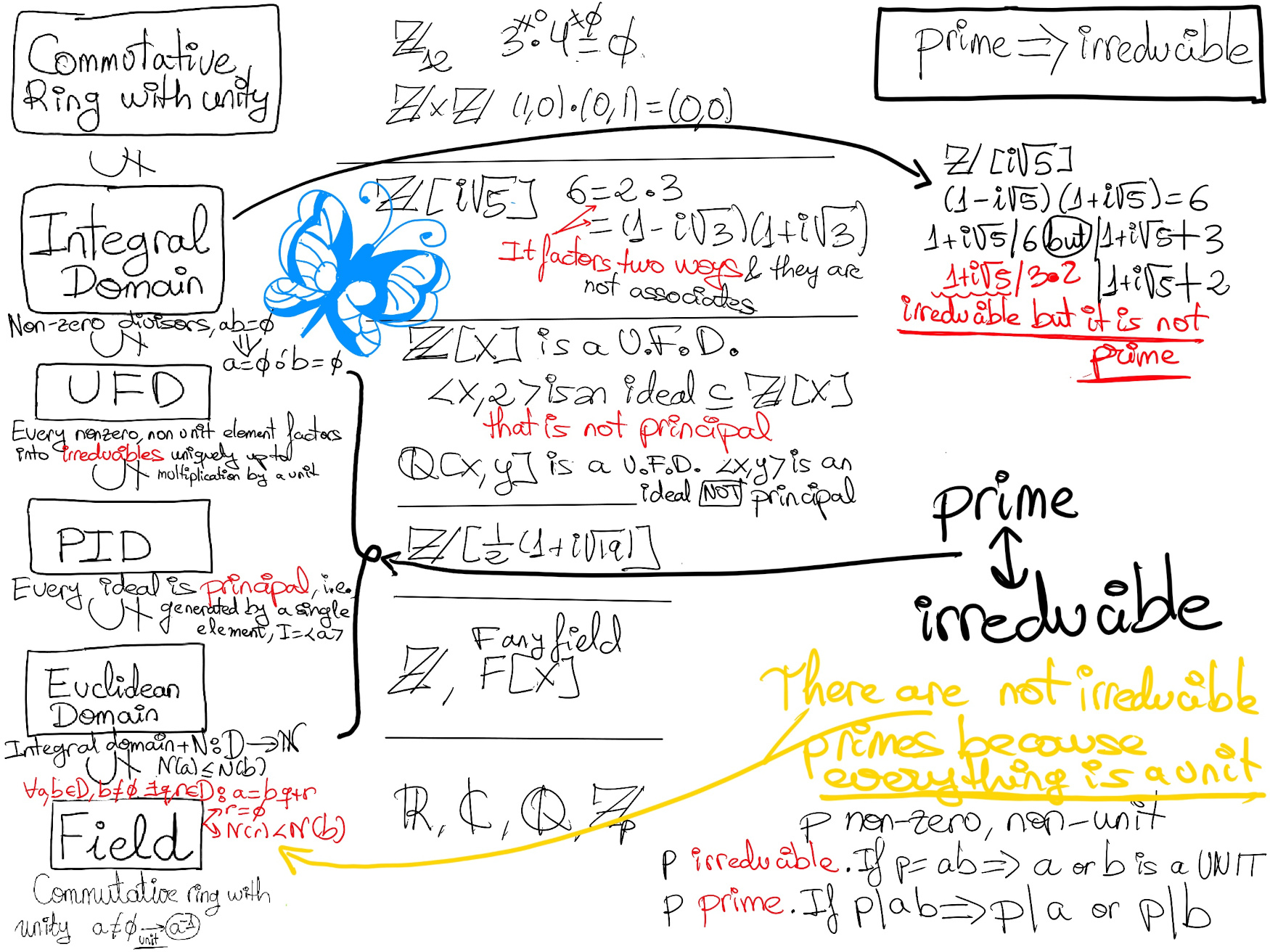
|
 |
 |

|
 |
 |
My appearance had improved substantially, but my pictures could still be sold to scare people, summon the devil, and kill the elderly. I was notice immediately, so many of my coworkers felt embarrassed and avoid hanging with me like eating shit or alien foreskin, Apocalypse, Anawim, #justtothepoint.
Definition. Let R be a commutative ring. A polynomial ring is a ring formed from the set of polynomials in one or more indeterminates or variables with coefficients in R. R[x] = {anxn + an-1xn-1+ ··· + a1x + a0 | ai ∈ R, n ∈ ℤ+}, e.g. 2x3+ 7x2 +4∈ ℤ[x], 2⁄3x2 + 4x -7 ∈ ℚ[x].
Division Algorithm. Let F be a field, f(x), g(x) ∈ F[x], g(x) ≠ 0. Then, there exists unique polynomials q(x) and r(x) ∈ F[x] such that

Definition. Let F be a field, let f, g ∈ F[x]. We say that g divides f (written g | f) or g is a factor of f if r is the zero polynomial.
Definition. A root of f(x) ∈ F[x] is an element α ∈ F such that f(α) = 0. Remark: f(x) ∈ ⟨x⟩ ↭ 0 is a root of f(x). Roots may exist in bigger or “extended” rings, e.g., 2x has no root in ℤ, but it has a root in ℚ, namely 1⁄2, x2 +1 has no roots in ℝ, but it has roots in ℂ, $\sqrt{i}$.
Factor Theorem. Let F be a field, and f ∈ F[x]. An element α ∈ F is a zero or a root of f (that is f(α) = 0) if and only if (x -α)|f(x), that is, there exist some q ∈ F[x] such that f(x) = (x - α)q(x).
Proof. By the division algorithm f(x) = (x - α)q(x) + r(x) where either r(x) = 0 or deg(r)< deg(x -α) = 1 ⇒ deg(r) = 0 ⇒ r is a constant.
Futhermore, f(α) = (α - α)q(α) + r(α) = r(α) ⇒ α is a zero (f(α) = 0) if and only if r is the zero polynomial. ∎
This result is directly derived from the factor Theorem. Let F be a field, and f ∈ F[x]. If f(x) has degree n and r1, r2,…, rn are the roots of f(x) in F, then f(x) can be uniquely represented as follows, f(x) = an(x - r1)(x - r2)···(x - rn)where an is the leading coefficient of f(x).
Examples: f(x) = x2 + 4 ∈ ℂ[x] has two roots, 2i and -2i ⇒ f(x) = (x - 2i)(x + 2i) -Figure 1.e.- g(x) = 2x2 + 4x + 5 ∈ ℤ7[x] has two roots, 2 and 3 ⇒ g(x) = 2(x -2)(x -3) where 2 = a2 is the leading coefficient of g(x).
Remainder Theorem. Let F be a field, α ∈ F, and f ∈ F[x]. Then, f(α) is the remainder of the division of f(x) by x-α.
Proof. By the division algorithm f(x) = (x - α)q(x) + r(x) where r(x) = 0 or deg(r) < deg(x -α) = 1 ⇒ deg(r) = 0 ⇒ r is a constant.
Futhermore, f(α) = (α - α)q(α) + r(α) = r(α) ∎
Example: f(x) = x7 -6x5 +4x4 -x2 +3x -7 ∈ ℚ[x], f(2) = -5 ⇒ f(x) = q(x)(x -2) -5 (Figure 1.d.). g(x) = x5 +3x4 + x3 + x2 +2x +2 ∈ ℤ5[x], 1 is root ⇒ g(x) = q(x)(x -1).

Corollary. A degree n polynomial over a field F has at most n distinct zeros in F, counting multiplicity.
Proof. Let’s proceed by induction on the degree of the polynomial, n.
A polynomial of degree n = 0 over a field has no zeros.
If deg(f(x)) = 1 ⇒ f(x) = ax + b, a ≠ 0. Suppose α, β ∈ F are zeros of f(x) ⇒ aα + b = f(α) = 0 = f(β) = aβ + b ⇒ aα + b = aβ + b ⇒[F field, the cancellation law applies] aα = aβ ⇒[F field, a ∈ F, a ≠ 0, a has an inverse, let’s multiply by a-1] α = β ⇒ f has at most 1-zero.
Suppose, f(x) is a polynomial of degree n over a field F, a is a zero of multiplicity k ⇒ f(x) = (x -a)kq(x) and q(a) ≠ 0 ⇒[F field ⇒ integral domain and def(f·g) = deg(f)+deg(g)] n = k + deg(q) ⇒ k ≤ n. There are two possibilities:
🚀 Let m be the multiplicity of b in q(x) ⇒ q(x) = (x-b)ms(x), s(x) ∈ F[x], s(b) ≠ 0 ⇒ f(x) = (x-a)n(x-b)ms(x) ⇒ b is a zero of f of multiplicity at least m. Suppose for the sake of contradiction, b is a zero of f of multiplicity greater than m ⇒ b is a zero of f(x)/(x-b)m = (x-a)ns(x) ⇒ 0 = (b -a)ns(b) ⇒[b ≠ a] s(b) = 0⊥ Therefore, b is a zero of f of multiplicity m.
Examples:
This result may not hold if F is not a field, e.g., in ℤ12[x], f(x) = x2 + 1, deg(f) = 2, but it has four distinct zeros, namely 1, 5, 7, and 11, and there is no a unique factorization, f(x) = (x -1)(x -11) = (x -5)(x -7).
Let’s find all complex zeros of xn -1.
De Moivre’s formula states that ∀x ∈ ℝ, n ∈ ℤ, (cosx + isinx)n = cos(nx) + isin(nx) where i is the imaginary unit (i2 = -1) ⇒ A nth root of unit are e(2kπi/n) = cos(2kπ/n) + isin(2kπ/n), k = 0, 1, ···, n -1, so there are already n, and by the previous corollary, we can see there are no other roots or zeroes of xn - 1.
Definition. A principal ideal is an ideal generated by a single element a of R though multiplication by every element of R, ⟨a⟩ = Ra = {ra | r ∈ R} = {ar | r ∈ R}. A ring R is a principal ideal domain (PID) if it is an integral domain such that every ideal of R is a principal ideal, that is, has the form ⟨a⟩ = Ra = {ra | r ∈ R} = {ar | r ∈ R}, e.g., ℤ, and if F is a field, both F and F[x] are PIDs, but ℤ[x] or F[x1, x2,···, xn], n ≥ 2 are not PIDs.
Proposition. The ring of integers ℤ is a PID.
Proof.
ℤ is a integral domain. Therefore, we only need to prove that every ideal of ℤ is principal.
Let I be an ideal of ℤ. If I = {0}, then I = ⟨0⟩, so I is a principal ideal.
Otherwise, I ≠ {0}, let a be the smallest integer such that a > 0 and a ∈ I. We claim that I = ⟨a⟩.
Proposition. If F is a field, then F is a PID.

Proof.
F field ⇒ F is an integral domain. Therefore, we only need to prove that every ideal of F is principal.
If I is a ring, and it has a non-zero element, say a ≠ 0, a ∈ I ⇒ ∀b ∈ F, b = [F is a field, every non-zero element has a multiplicative inverse ∃a-1: a·a-1 = a-1·a = eF, and obviously ba-1 ∈ F, a ∈ I, I ideal] (ba-1)a ∈ I ⇒ ∀b∈ F, b ∈ I ⇒ I = F. As a consequence, the only ideals of any field F are the trivial ideal and the entire field, {0} = ⟨0⟩ and F = ⟨1⟩.
Proposition. If F is a field, then the ring of polynomials F[x] is a PID.
Proof.
F field ⇒ F is an integral domain ⇒[Recall Let D be a commutative ring with unity 1. Then, D[x] is an integral domain if and only if D is an integral domain.] F[x] is an integral domain. Therefore, we only need to prove that every ideal of F[x] is principal.
Let I ∈ F[x] be an ideal. If I = {0}, then I = ⟨0⟩.
Otherwise, let g(x) ≠ 0 be a polynomial of minimum degree, that is, such that g(x) ∈ I, deg(g(x)) ≤ deg(p(x)) ∀p(x) ∈ I - {0}. We claim that I = ⟨g(x)⟩
Theorem. Let F be a field, I a nonzero ideal in F[x], and g(x) ∈ F[x]. Then, I = ⟨g(x)⟩ ↭ g(x) is a nonzero polynomial of minimum degree in I, that is, the smallest possible degree among the degrees of nonzero polynomials in I (the proof is provided for free on the previous theorem’s proof)
Counterexample: ℤ[x] is not a PID.
Proof. Let’s consider the ideal ⟨2, x⟩. This ideal is not principal.
Suppose for the sake of contradiction that I = <2, x> in ℤ[x] is principal ⇒ ∃f(x) ∈ ℤ[x] such that I = < f(x) >. As 2 ∈ I, there exists g(x) ∈ ℤ[x] such that 2 = f(x)g(x) ⇒ def(f(x)) + deg(g(x)) = deg(f(x)g(x)) = 0 ⇒ deg(f(x)) = deg(g(x)) = 0 ⇒ [2 = f(x)g(x)] ∃a, b ∈ ℤ: 2 = ab ⇒ f(x) = a = ±1 or ±2.
If a = ±1 then < 2, x > = < 1 > ⇒ ∃r(x), s(x) ∈ ℤ[x]: 1 = 2r(x) + xs(x). Evaluating these polynomials for x = 0, then 1 = 2r(0), so that r(0) = 1/2 ⊥ r(0) ∈ ℤ.
If a = ±2 then < 2, x > = < 2 > ⇒ ∃v(x) ∈ ℤ[x]: x = 2v(x). Then, v(x) = 1/2x ⊥ v(x) ∈ ℤ[x].
Definition. Let F be a field. Given two polynomials of F, say f(x), g(x) ∈ F[x], we say a monic polynomial d(x) (the coefficient of the leader term is equal to one) is the greatest common divisor of f and g, and we write it as d(x) = gcd(f(x), g(x)), if d(x)|f(x) and d(x)|g(x) and if ∃c(x) ∈ F[x] such that c(x)|f(x) and c(x)|g(x), then c(x)|d(x).
Definition. Let F be a field, two polynomials of F, say f(x), g(x) ∈ F[x]. If gcd(f(x), g(x)) = 1, then we say that both polynomials f and g are relatively prime.
Recall Bézout’s identity. Let a and b be integers with greatest common divisor d. Then there exist integers x and y such that ax + by = d. The following theorem shows that if F is a field, F[x] behaves quite a lot like ℤ.
Theorem. Given two polynomials of a non-empty field F, say f(x), g(x) ∈ F[x] with greatest common divisor d(x), d(x) = gcd(f(x), g(x)). Then, there exist two polynomials a(x), b(x) ∈ F[x] such that d(x) = a(x)f(x) + b(x)g(x).
Proof.
Consider S = {u(x)f(x) + v(x)g(x)| u(x), v(x)∈ F[x]} ≠ ∅ (e.g. u(x) = 1, v(x) = 0, ∀f(x) ∈ F[x], f(x) ∈ S and F is a non-empty field) and since the degrees of the elements in S are natural numbers (well-ordered), take d(x) ∈ S the monic polynomial of minimal degree ⇒ ∃a(x), b(x) ∈ F[x]: d(x) = a(x)f(x) + b(x)g(x).
1st Claim: d(x)|f(x).
By the division algorithm, f(x) = q(x)d(x) + r(x) where either r(x) = 0 or deg(r(x)) < deg(d(x)).
r(x) = f(x) -q(x)d(x) =[d(x) = a(x)f(x) + b(x)g(x)] f(x) -q(x)(a(x)f(x) + b(x)g(x)) = (1 -a(x)q(x))f(x) -q(x)b(x)g(x) ∈ S we only need to rename (1 -a(x)q(x)) = u(x), -q(x)b(x) = v(x) ⇒[By assumption, d(x) is the monic polynomial of minimal degree in S] r(x) = 0 ⇒ f(x) = q(x)d(x) ⇒ d(x)|f(x). Mutatis mutandis, d(x)|g(x).
2nd Claim: d(x) = gcd(f(x), g(x))
Suppose there exist c(x) ∈ F[x] such that c(x)|f(x) and c(x)|g(x) ⇒∃p(x), q(x) ∈ F[x], f(x) = c(x)p(x) and g(x) = c(x)q(x) ⇒ d(x) = a(x)f(x) + b(x)g(x) = a(x)c(x)p(x) + b(x)c(x)q(x) = c(x)(a(x)p(x) + b(x)q(x)) ⇒ d(x) = c(x)(a(x)p(x) + b(x)q(x)) ⇒ d(x)|c(x) ⇒ d(x) = gcd(f(x), g(x)).
3rc Claim: the gcd is unique.
Suppose d’(x) is also a greatest common divisor of f(x) and g(x) ⇒ d’(x)|f(x) and d’(x)|g(x) ⇒ ∃p(x), q(x) ∈ F[x]: f(x) = d’(x)p(x) and g(x) = d’(x)q(x) ⇒ d(x) = a(x)f(x) + b(x)g(x) = a(x)(d’(x)p(x)) + b(x)(d’(x)q(x)) = d’(x)(a(x)p(x) + b(x)q(x)) ⇒ d(x) = d’(x)(a(x)p(x) + b(x)q(x)) ⇒ deg(d(x)) = deg(d’(x)) + deg(a(x)p(x) + b(x)q(x)) ⇒[🚀deg(d(x)) = deg(d’(x))] deg(a(x)p(x) + b(x)q(x)) = 0 ⇒ a(x)p(x) + b(x)q(x) = α, α ∈ F, and d(x) = αd’(x) and d and d’ are monic polynomials ⇒ By considering the leader term, 1 = α ⇒ d(x) = d’(x)∎
🚀d(x)|f(x) and d(x)|g(x) ⇒[d’(x) = gcd(f(x), g(x))] d(x)|d’(x). Similarly, d’(x)|f(x) and d’(x)|g(x) ⇒[d(x) = gcd(f(x), g(x))] d’(x)|d(x) ⇒ d(x)|d’(x) and d’(x)|d(x) ⇒ deg(d(x)) = deg(d’(x))